Acer Aspire One 751h: NetbookSize++
by Jarred Walton on September 3, 2009 12:00 AM EST- Posted in
- Laptops
Netbook Performance Comparison
You can read about our testing setup and the other laptops used in our previous GIGABYTE M1022 review. None of the results changed for this article, so we'll dispense with most of the commentary to keep things short.

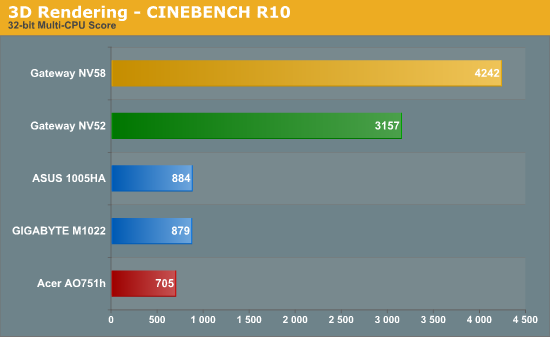
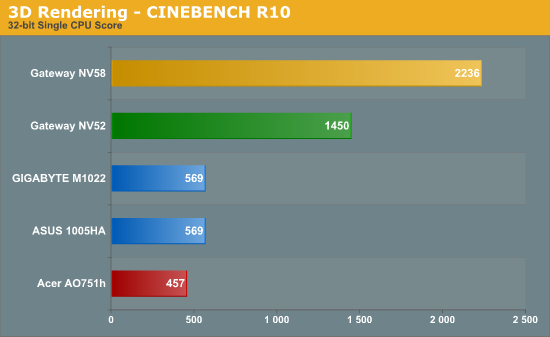

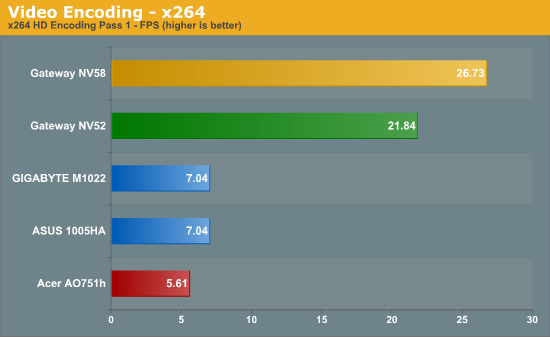
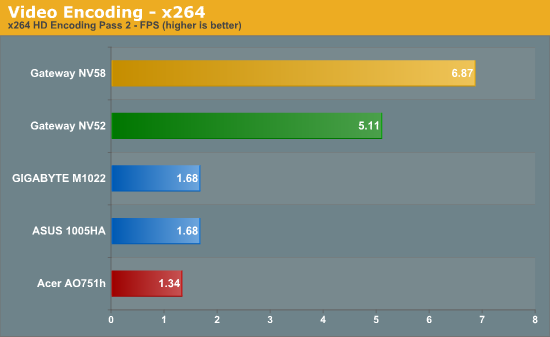
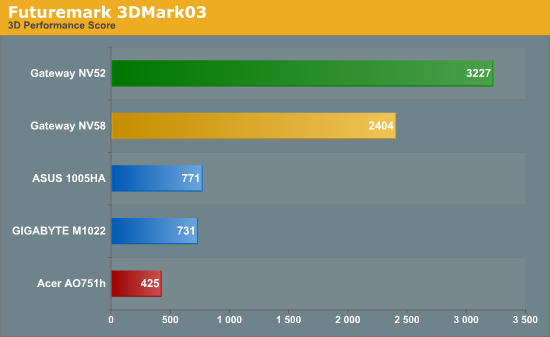
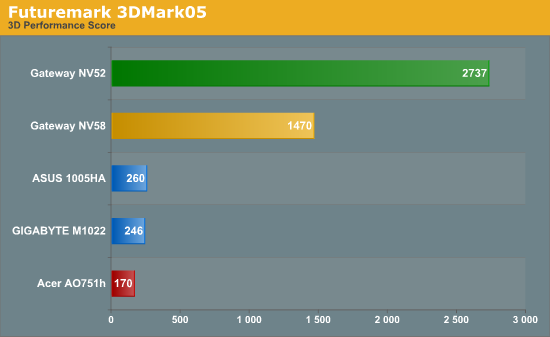
 |
The performance picture shows that the Atom Z520/Poulsbo combination is clearly slower than the Atom N280/945GSE platform. How much of the slowdown comes from the 25% lower CPU clock varies by application, and you can see by the 3DMark results that the GMA 500 is anything but a high-performance 3D solution. In fact, in 3D applications the GMA 950 is anywhere from 45% to 75% faster than the GMA 500. Overall performance ends up somewhere between the old ASUS Eee PC 4G and the more recent Eee PC 901, which is still typically "fast enough" for office and Internet use.
One element of performance that's not immediately visible from the above graphs is the video playback capabilities. All of the other systems are able to handle 720p x264 decoding -- albeit barely in the case of the 1005HA and M1022. Those two netbooks require the use of the CoreAVC codec in order to avoid dropping frames. Unfortunately, the Atom Z520 isn't able to decode HD x264 videos without severe stuttering. The good news is that the US15W/GMA 500 chipset includes support for HD video, provided you have the right software. PowerDVD 8 -- included on the system -- has an H.264/AVC codec that works with the chipset and easily handles x264 decoding. The Z520 CPU can also handle less strenuous codecs on its own (HD DivX and Xvid for example), but we do have to warn that any multitasking -- even opening menus -- while watching videos causes severe stuttering.
Final Update: After further testing, I have revised the above text to summarize the video codec situation better. Initially, I was not able to view x264 videos, but with some searching and suggestions from readers I finally got it sorted out. Worth noting is that testing under Windows 7 did not go so well, but Intel doesn't yet offer official Windows 7 drivers for the GMA 500 -- you have to use the Vista drivers, and I experienced numerous crashes after going that route. I did not test Vista, but others report no serious issues, and under XP things worked fine for the most part. I still get the occasional crash when launching some applications (particularly video players with HD content), and it appears to be a driver issue. The latest GMA 500 XP drivers are "for developers", so they're essentially beta still. For x264 playback acceleration, I used Media Player Classic - Home Cinema and the PowerDVD 8 H.264/AVC Decoder (set it as the preferred codec in the External Filters section).










30 Comments
View All Comments
Finally - Thursday, September 3, 2009 - link
...but what's the keyboard size?A bigger, higher resolution display is definitely the way to go, but I want full-sized keys and a non-glossy display - and that's the reason why I haven't bought any netbooks yet.
JarredWalton - Thursday, September 3, 2009 - link
If you look at the gallery, you can see the keyboard makes use of the whole area - i.e. no unused space on the right and left sides. I believe the keys are 100% standard desktop keyboard sized, though obviously it's not a 101-key layout. I felt the keyboard was definitely better than the smaller 10.1" and 9.1" netbooks.TA152H - Thursday, September 3, 2009 - link
It's strange to read an article without P55 motherboard pictures. Is this site under new management?I'm in the market for one of these, but I'd never tolerate the slower clock speed processor. When you factor in the very insignificant power difference, I don't think the processor is attractive for most people. Whatever percentage less it is than the N270/N280, they are very low percentages of the power draw for the computer, so it's really not going to make a big difference in systemic power draw.
Really, Intel kind of did something very un-Intel with the Atom. Even when they had the dreadful Netburst processors, they at least surrounded them with good packaging, including software compilers, good chipsets, good motherboards, etc...
With the Atom, from a purely processor perspective, they have a really nice product, but they shackle it with a perfectly dreadful chipset. It's bizarre. On top of that, they're taking too long to get out something better. I'm really getting impatient waiting to be able to buy one of these things, since I won't buy 945, and I won't buy NVIDIA crap. I wish AMD had something decent, but they don't, so a lot of us just have to wait.
Also, these mirror like screens are a nightmare, and becoming more popular. Especially for something ultra-portable, don't these makers realize that people bring them outside? They must be cheaper to make, since they seem to go to great efforts to convince us that we want them, but I don't. Is anyone else a little annoyed by the number of mirrors they sell parading as displays? It's not so bad if there's a choice, but more and more, it's getting difficult to get an anti-glare screen.
chrnochime - Thursday, September 3, 2009 - link
You might want to consider the Samsung NC20, which comes with via nano cpu + chrome graphics. Not that blazing fast, but if tunes correctly ,goes at least as fast as the N270/280, and does basic work fine. Another is the Lenovo S20, which costs about the same, ~400USD.If you need a decent fast CPU, consider the Acer Timeline. The base 3810T(13.3") comes with a ULV Intel processor that's more akin to Pentium M than the atom. Priced around 500 I think. That or higher priced, with Core 2 Solo, or even Core 2 duo.
I might've gotten the CPU model name wrong in the timeline, but the CPUs in the timelines are much better than the Atom...
Penti - Wednesday, September 9, 2009 - link
Actually just get Intel CULV if you need more performance, they will also have chipsets available that does have working hw acceleration of video. (The 11.6" Timeline/aspire is CULV, 1.3GHz Penryn based).The prices for the CULVs are decent any way, considering you also get a real version of windows with it. HW acceleration at least works on GS40/GMA4500MHD. Which means a lot on small less powerful notebooks. And you get W7 upgrade too. Costs only around $450. Still is about the size of a large netbook. I think it got a C2S 1.4GHz for that price though. No real reason to go to atoms for such devices any how.
TA152H - Thursday, September 3, 2009 - link
To be honest, as much as I wanted to like the Nano, to me it's a big disappointment as it currently exists. I don't really this this as a competitive processor in most situations. Where you can get the power down to the point it matches the Atom, it gets beaten in a lot of benchmarks, and if you use one of the higher power ones, you start running into Core 2 territory, or one of the lesser derivatives of it. Given the really excellent Intel designs, Centaur had to get theirs right, and so far it's just not there. Possibly a shrink to 45nm will improve the power characteristics, and some tweaking might improve performance, so I'm still hopeful. But, as it exists today, it's interesting, but not particularly useful. The bad part is, at least for them, is it will get a lot more difficult once Intel comes out with a decent chipset and moves to 32nm. Their own chipsets are still stuck at DX 9, and aren't particularly good either.They had a long time being alone in that market, and they've had a pretty long time where Intel had the processor, but not the chipset. They failed miserably even with that. They came out with nice form factors and such, but never really broke into the market because their products basically suck. I have an 800 MHz part that gets raped by my K6-III+, underclocked to 400 MHz. It uses less power, generates less heat, and outperforms the VIA chip, despite being roughly 6 years older. Now the Nano was a big step up, and maybe it's good if you take it outside of the context of excellent Intel processors, but, within the context of what exists in the marketplace, I don't see it making much sense for a lot of buyers. Again, I'm not blaming them entirely; AMD can't compete with Intel either. It's probably just that Intel makes such attractive products, positioning against them is extremely difficult. On the other hand, still being on 65nm, and not supporting DX10 are issues not related to Intel, that should have been taken care of a while ago. They can't make mistakes like this.
I was looking at Core 2 based notebooks, but it's gotten to the point where I couldn't find a anti-glare screen at HP. I'm allergic to Dell, and merely disgusted with HP. I won't buy Lenovo, since they're Chinese and not American, and we already import too much from them. Sadly, I don't know much about makers, since I don't buy from them, and don't have a job where I have to deal with them. It's a pity there's no way to build a notebook, but, sadly, we have to buy from companies we know suck. It's a disagreeable situation, but, what can one do if they need one of these things?
Etern205 - Thursday, September 3, 2009 - link
Out of all of them, there is only one model which has Windows XP Professional instead of XP Home.Etern205 - Thursday, September 3, 2009 - link
Never mind looks like it's already mentioned.bjacobson - Thursday, September 3, 2009 - link
I wouldn't worry about it. Better to get the Vista version and get the free upgrade to Windows 7.I have an AO751h and absolutely love it. Installed 2g of ram myself, Windows 7, turn off window transparency and you're good to go-- this thing has 6-8h battery life depending on how bright the screen is (I seem to get 7h with it on the lowest brightness setting) and is FAST. The GMA500 graphics chip can accelerate 1080p video-- if you get the drivers installed right (don't run the setup.exe from Intel, make sure you install through Device Manager).
Whatever tweaking they did to Windows 7 to make it faster than Vista WORKED. Idles at ~1-3% with that Atom, and is very responsive once you get Chrome running (Firefox a bit slower). Now I give them about a year before they add the bloat back in through "Security" updates and it slows to a grinding halt (just like what happened to XP).
The0ne - Thursday, September 3, 2009 - link
As I've been telling unbelievers of Windows 7, all they really to do is install it on a older desktop/laptop and see the difference. Whatever MS changed with Windows 7 it's working wonders on older PCs and even newer crawling PCs with Vista pre-installed.I'm waiting for someone to find out why this is so as I'm too lazy and no time! to look into it myself :D